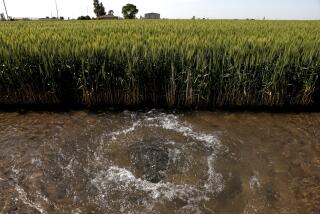California approves big fines for wasting water during drought
- Share via
Cities throughout California will have to impose mandatory restrictions on outdoor watering under an emergency state rule approved Tuesday.
Saying that it was time to increase conservation in the midst of one of the worst droughts in decades, the State Water Resources Control Board adopted drought regulations that give local agencies the authority to fine those who waste water up to $500 a day.
Many Southern California cities, including Los Angeles, Santa Barbara and Long Beach, already have mandatory restrictions in place.
But most communities across the state are still relying on voluntary conservation, and Californians in general have fallen far short of meeting Gov. Jerry Brown’s January call for a 20% cut in water use.
The emergency rules, expected to take effect Aug. 1, don’t order cities to slash water use by a certain amount. Rather they direct agencies to — at a minimum — ban wasteful practices such as allowing runoff from outdoor sprinklers, hosing down driveways and sidewalks and using drinking water in ornamental fountains that don’t recirculate.
“It’s not going to be a huge change from what we already have,” said Kevin Pearson, media relations officer of the Eastern Municipal Water District, which has voluntary measures in place for the 768,000 people it serves in western Riverside County.
Los Angeles, which since 2009 has limited outdoor watering to three days a week, is stepping up enforcement of its conservation ordinance and also recently boosted its cash-for-grass rebate to $3 a square foot.
The watering limits would be primarily enforced by local government and water districts, which are expected to issue warnings and fines that escalate with repeat offenses.
But the state board would also have enforcement authority.
Before the board vote in Sacramento, representatives of several Southern California agencies pointed out that the region has been a state leader in urban water conservation.
They expressed concerns that cities that have achieved significant savings in recent years were being painted with the same brush as communities that have lagged in conservation.
But Madelyn Glickfeld, assistant outreach director of the UCLA Institute of the Environment and Sustainability, told the board that despite the Southland’s conservation strides, residents “don’t get this drought.”
She cited lush lawns and freeway sprinklers spraying next to the electronic Caltrans signs urging water savings.
Updated results of a state board survey show that statewide, urban water use in May increased 1% compared to the May average of the previous three years.
That rise was mostly driven by an 8% jump in coastal Southern California.
In most other hydrologic regions, May use declined. The biggest drop was in the Sacramento River area, where it fell 13%.
On Twitter, follow: @boxall
More to Read
Sign up for Essential California
The most important California stories and recommendations in your inbox every morning.
You may occasionally receive promotional content from the Los Angeles Times.











